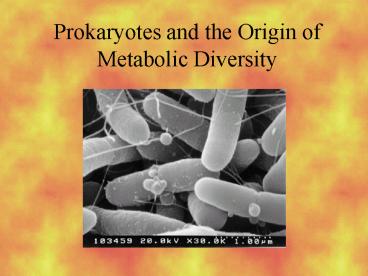Prokaryotes and the Origin of Metabolic Diversity - PowerPoint PPT Presentation
1 / 52
Title:
Prokaryotes and the Origin of Metabolic Diversity
Description:
rod shaped, Gram negative, lophotrichous. chemoheterotrophs. Pseudomonas ... Sulfolobus (hot springs of Yellowstone National Park) - oxidizes sulfur ... – PowerPoint PPT presentation
Number of Views:192
Avg rating:3.0/5.0
Title: Prokaryotes and the Origin of Metabolic Diversity
1
Prokaryotes and the Origin of Metabolic Diversity
2
Prokaryotes
- Kingdom Monera
- Cell wall composed of murein (peptidoglycan)
- includes
- Actinomycetes
- chemoautotrophic bacteria
- cyanobacteria
- endospore forming bacteria
- enteric bacteria
- mycoplasmas
- myxobacteria
- nitrogen fixing aerobic bacteria
- phototrophic anaerobic bacteria
- pseudomonads
- rickettsias
- chlamydias
- spirochetes
3
Actinomycetes
- Colonies of branching hyphae
- reproduction - fragmentation of ends to form
spores - organic litter of soil
- Mycobacterium, Streptomyces
4
Chemoautotrophic Bacteria
- Energy from oxidizing NH3, NO3-, H2S, S, and Fe3
CO2 - obligate aerobes
- aerated soil
- Nitrobactere, Nitrosomonas
5
Cyanobacteria
- Photoautotrophs
- chlorophyll a
- phycobilins
- nitrogen fixation
- in heterocysts
- Nostoc, Anabaena,
- Oscillatoria
6
Endospore Forming Bacteria
- Gram positive, flagellated rods
- endospores
- obligate anaerobes aerobes
- Bacillus, Clostridium
7
Enteric Bacteria
- Gram negative
- facultative anaerobes
- intestinal tracts
- natural
- pathogenic
- Escherichia, Salmonella,Vibrio
8
Mycoplasmas
- Smallest of all cells (0.10-0.25 microns)
- no cell walls
- extracellular growth
- saprobes and animal pathogens
- Mycoplasma
9
Myxobacteria
- Soil dwelling chemoheterotrophs
- gliding movement
- congregate into fruiting masses
- Myxococcus
10
Nitrogen-Fixing Aerobic Bacteria
- Free-living mutualistic
- important in nutrition of plants
- nodules of legumes
- Rhizobium
11
Phototrophic Anaerobic Bacteria
- Do not release oxygen
- strict anaerobes
- ponds, lakes, ocean sediments
- purple green sulfur bacteria
- Chromatium, Rhodospirillum
12
Pseudomonads
- Nearly all aquatic and soil habitats
- rod shaped, Gram negative, lophotrichous
- chemoheterotrophs
- Pseudomonas
13
Rickettsias and Chlamydias
- Obligate intracellular parasites of animals
- reduced Gram negative wall
- Rickettsias alternate between arthropod and
mammal hosts - Chlamydias contracted from other humans or birds
- Rickettsia, Chlamydia
14
Spirochetes
- Helical cells
- corkscrew-like movement with internal flagella
- free-living saprobes and parasites
- Borrelia, Treponema
15
Bacterial Shapes
- Three basic shapes
- coccus
- bacillus
- spirillus
- Variations in shapes
- strepto-
- staphlo-
- sarcinae
- diplo
- tetrads
- vibrio
16
(No Transcript)
17
(No Transcript)
18
External Structure
- Flagella
- parts
- hook
- flagellum proper
- rings
- s
- m
- l
- p
19
L ring
P ring
S ring
M ring
20
Flagellum
- Arrangement
- atrichous
- monotrichous
- peritrichous
- lophotrichous
- Composition
- flagellin (protein)
- ?-N-methyl lysine
21
Pilus
- Functions
- F pilus (sex pilus)
- attachment site for bacteriophages
- adherence
- Spines
- Gram (-) marine species
- unknown function
22
Capsules
- Composition
- some have dextrans, levans, or celluloses
- some have above in combination with muceins
- uronic acid
- Pathogenic species often encapsulated
23
Slime Layers
- Gelatinous material on cell walls
- Unorganized
24
Cell Walls
- Functions
- prevent rupture due to osmotic pressure
- support for flagella
- maintain shape of bacteria
25
Cell Walls
- Composition
- diaminopimelic acid (DPA) in those that lack
lysine - teichloic acid (formed from N-acetylglucoasamine
NAG) - muramic acid (from N-acetylmuramic acid NAM)
- common amino acids
- uncommon amino acids
26
(No Transcript)
27
(No Transcript)
28
Gram Stain
29
Bacterial Structure(Internal)
- Cell Membrane
- similar to fluid-mosaic model in eukaryotic cells
30
Cell Membrane
- Functions
- controls passage of nutrients wastes
- location of several cytochromes for
photosynthesis and respiration - location of enzymes for cell wall synthesis
- enzymes for electron transport system
31
Mesosomes
- Mostly in Gram
- pocket-like
- contain tubules or lamellae
- Functions
- cell wall synthesis
- division of DNA
- respiration
- spore formation
32
Genetic Material
- Circular DNA
- Plasmids (DNA)
- capable of independent replication
- gives drug resistance
- not essential for life
33
Ribosomes
- 40 protein, 60 RNA
- 90 of cell RNA is in ribosomes
- 70s (Svedberg sedimentation coefficient)
34
Photosynthetic Apparatus
- Tied to cell membrane
- pigments stored in vesicles or thylakoids
35
Protoplasmic Inclusions
- Non-membrane bound
- Metachromatic granules (volutin)
- stain red with aged methylene blue
- functions
- storage of inorganic phosphates
- storage of food
- Polysaccharide granules
- starch and glycogen
36
Protoplasmic Inclusions
- Membrane Bound
- carboxysomes (fix CO2 in photosynthesis)
- lipids
- gas vacuoles
- aquatic prokaryotes
- functions
- cell buoyancy
- protect from uv radiation
- regulate surface area/volume relationships
- combination of above
37
Protoplasmic Inclusions
- Spores
- bacterial
- endospores
- exospores
- cysts
- conidia
38
Protoplasmic Inclusions
- Spores
- cyanobacteria
- heterocysts
- akinetes
39
Reproduction
- Asexual
- binary fission
- Sexual
- transformation
- conjugation
- transduction
40
(No Transcript)
41
(No Transcript)
42
(No Transcript)
43
(No Transcript)
44
(No Transcript)
45
(No Transcript)
46
(No Transcript)
47
(No Transcript)
48
(No Transcript)
49
Archaebacteria
- Cell walls lack peptidoglycan
- distinct lipid composition of cell membranes
- RNA polymerase and ribosomal protein more
eukaryotic-like - live in extreme environments
- methanogens
- halophiles
- thermoacidophiles
50
Methanogens
- H2 used to reduce CO2 to methane (CH4)
- strict anaerobes
- swamps and marshes
- decomposers of sewerage
- farmers use to convert garbage and dung to
methane - inhabit guts of animals (termites, cows)
51
Extreme Halophiles
- Live in saline places as Great Salt Lake, Dead
Sea - other species simply tolerate saline conditions,
these thrive - pink pigment present in some call
bacteriorhodopsin
52
Thermoacidophiles
- Live in hot, acidic areas
- optimum temperature is 60-80 C and pH of 2-4
- Sulfolobus (hot springs of Yellowstone National
Park) - oxidizes sulfur































